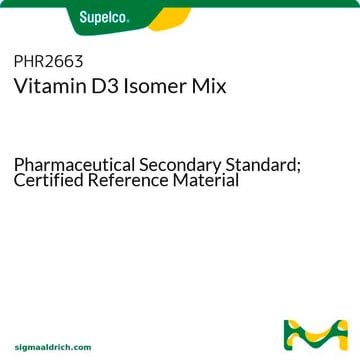If this product has an expiration or retest date, it will be shown on the Certificate of Analysis (COA, CofA). If there is no retest or expiration date listed on the product's COA, we do not have suitable stability data to determine a shelf life. For these products, the only date on the COA will be the release date; a retest, expiration, or use-by-date will not be displayed.
For all products, we recommend handling per defined conditions as printed in our product literature and website product descriptions. We recommend that products should be routinely inspected by customers to ensure they perform as expected.
For products without retest or expiration dates, our standard warranty of 1 year from the date of shipment is applicable.
For more information, please refer to the Product Dating Information document: https://www.sigmaaldrich.com/deepweb/assets/sigmaaldrich/marketing/global/documents/449/386/product-dating-information-mk.pdf
PHR1237
Cholecalciferol (Vitamin D3)
Pharmaceutical Secondary Standard; Certified Reference Material
Synonym(s):
Cholecalciferol, (+)-Vitamin D3, 7-Dehydrocholesterol activated, Activated 7-dehydrocholesterol, Calciol
Select a Size
About This Item
Recommended Products
grade
certified reference material
pharmaceutical secondary standard
Quality Level
Agency
traceable to BP 787
traceable to Ph. Eur. C2100000
traceable to USP 1131009
API family
cholecalciferol
form
solid
CofA
current certificate can be downloaded
technique(s)
HPLC: suitable
gas chromatography (GC): suitable
mp
83-86 °C (lit.)
application(s)
food and beverages
format
neat
storage temp.
-10 to -25°C
SMILES string
CC(C)CCC[C@@H](C)[C@@]1([H])CC[C@@]([C@]1(C)CCC/2)([H])C2=C\C=C(C[C@@H](O)CC3)/C3=C
InChI
1S/C27H44O/c1-19(2)8-6-9-21(4)25-15-16-26-22(10-7-17-27(25,26)5)12-13-23-18-24(28)14-11-20(23)3/h12-13,19,21,24-26,28H,3,6-11,14-18H2,1-2,4-5H3/b22-12+,23-13-/t21-,24+,25-,26+,27-/m1/s1
InChI key
QYSXJUFSXHHAJI-YRZJJWOYSA-N
Gene Information
human ... VDR(7421)
Looking for similar products? Visit Product Comparison Guide
General description
Cholecalciferol (vitamin D3) is a fat-soluble vitamin that manifests skeletal and extra-skeletal effects. The skeletal effects augment the bone health whereas the extra-skeletal effects concern the immune system, the cognition, the cardiovascular system, etc.[1]
Application
Biochem/physiol Actions
Analysis Note
Other Notes
Footnote
Recommended products
related product
Signal Word
Danger
Hazard Statements
Precautionary Statements
Hazard Classifications
Acute Tox. 2 Dermal - Acute Tox. 2 Inhalation - Acute Tox. 2 Oral - STOT RE 1 Oral
Storage Class Code
6.1A - Combustible acute toxic Cat. 1 and 2 / very toxic hazardous materials
WGK
WGK 2
Flash Point(F)
Not applicable
Flash Point(C)
Not applicable
Certificates of Analysis (COA)
Search for Certificates of Analysis (COA) by entering the products Lot/Batch Number. Lot and Batch Numbers can be found on a product’s label following the words ‘Lot’ or ‘Batch’.
Already Own This Product?
Find documentation for the products that you have recently purchased in the Document Library.
Customers Also Viewed
Protocols
Ascentis Express C18 is suitable for routine analysis of fat-soluble vitamins D2 and D3, providing optimized chromatograms.
Separation of Ergocalciferol (D2), analytical standard; Cholecalciferol (D3), analytical standard
Separation of (±)-α-Tocopherol, analytical standard; Menadione (K3), analytical standard; (+)-γ-Tocopherol, analytical standard; Cholecalciferol (D3), analytical standard
-
How can I determine the shelf life / expiration / retest date of this product?
1 answer-
Helpful?
-
-
How is shipping temperature determined? And how is it related to the product storage temperature?
1 answer-
Products may be shipped at a different temperature than the recommended long-term storage temperature. If the product quality is sensitive to short-term exposure to conditions other than the recommended long-term storage, it will be shipped on wet or dry-ice. If the product quality is NOT affected by short-term exposure to conditions other than the recommended long-term storage, it will be shipped at ambient temperature. As shipping routes are configured for minimum transit times, shipping at ambient temperature helps control shipping costs for our customers. For more information, please refer to the Storage and Transport Conditions document: https://www.sigmaaldrich.com/deepweb/assets/sigmaaldrich/marketing/global/documents/316/622/storage-transport-conditions-mk.pdf
Helpful?
-
-
I assume the material will be shipped with dry ice. So up to how many days/time the material will remain stable in this shipping condition ?
1 answer-
This product is stable for relatively short periods of time. The item is shipped at ambient temperature. A transit time of up to 2 weeks will not impact the quality of this material. Upon delivery, this product should be stored at -20°C.
Helpful?
-
Active Filters
Our team of scientists has experience in all areas of research including Life Science, Material Science, Chemical Synthesis, Chromatography, Analytical and many others.
Contact Technical Service









